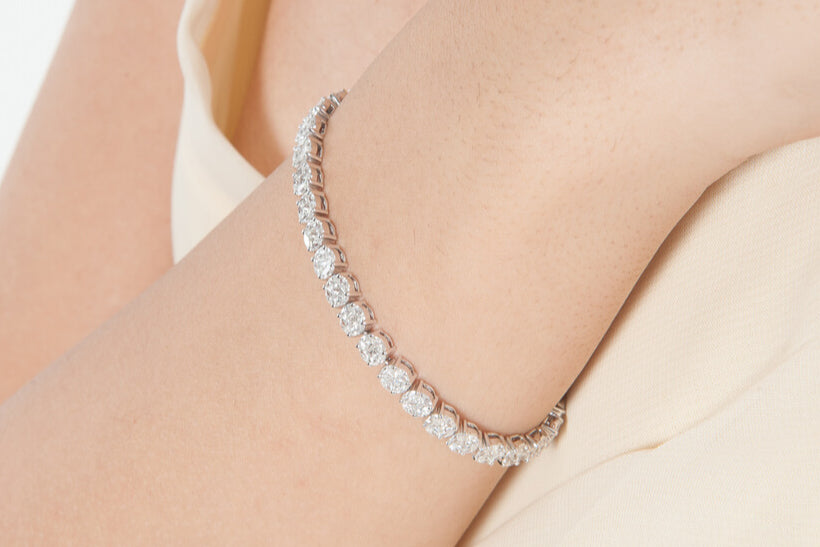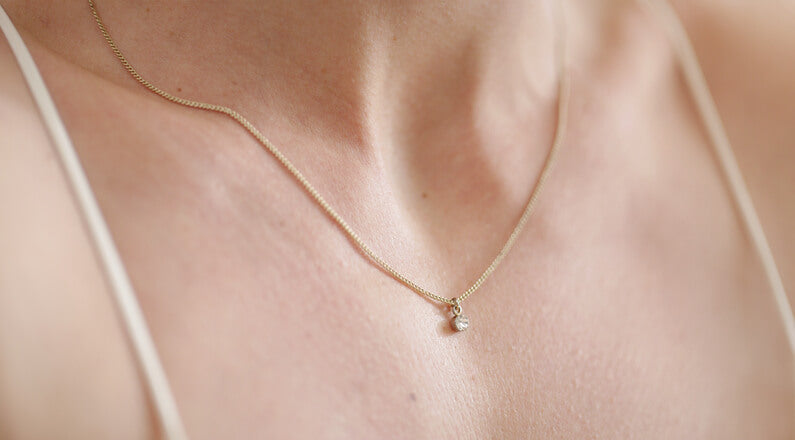Discovering Moissanite: The Underrated Gemstone That's Changing the Jewelry Landscape
Moissanite, a gemstone that's been around for over a century, remains a hidden treasure for many jewelry enthusiasts. This brilliant, eco-friendly, and affordable alternative to diamonds has been overshadowed by the marketing prowess of the diamond industry. In this article, we'll uncover the reasons why moissanite has remained relatively unknown and explore its potential to revolutionize the jewelry market.
The Dominance of the Diamond Industry
The diamond industry has a long history that dates back to thousands of years ago, when diamonds were first discovered in India. However, it was the 19th-century discovery of vast diamond deposits in South Africa that truly fueled the global diamond trade. This led to the formation of the De Beers Group, a company that would go on to dominate the diamond industry for decades.
Established in 1888 by Cecil Rhodes, the De Beers Group swiftly consolidated its control over diamond mines, establishing a monopoly that, at its peak, controlled approximately 90% of the world's diamond production. Through its control of supply, De Beers successfully maintained high diamond prices and limited the availability of this precious gemstone in the market.
One of the key strategies that allowed the De Beers Group to maintain its grip on the diamond industry was its marketing prowess. In 1947, De Beers launched the iconic "A Diamond is Forever" campaign, which played a crucial role in positioning diamonds as the ultimate symbol of love, commitment, and luxury. This marketing campaign emphasized the idea that a diamond engagement ring was the only acceptable way to propose, and that the size and quality of the diamond were a reflection of one's love and financial success.
The success of this campaign cannot be overstated. Before the 1940s, diamond engagement rings were not as popular as they are today. However, the "A Diamond is Forever" campaign managed to persuade the public that diamonds were the only suitable option for engagement rings, effectively creating a lasting tradition that is still widely embraced today.
In addition to the "A Diamond is Forever" campaign, the De Beers Group also utilized other marketing techniques to further promote diamonds as the ultimate symbol of luxury. For example, they popularized the "four Cs" (carat, cut, clarity, and color) to educate consumers about the factors that determine a diamond's quality and value, which in turn encouraged customers to seek out the most expensive, high-quality diamonds.
The dominance of the diamond industry, along with the successful marketing campaigns by De Beers, has made it difficult for alternative gemstones, like moissanite, to gain widespread recognition and acceptance. However, as more consumers become aware of the ethical and environmental concerns surrounding the diamond industry, the demand for sustainable and ethical alternatives like moissanite is on the rise.
The Origins of Moissanite: From Meteorites to Lab-Grown Stones
Moissanite is a gemstone with a fascinating history that dates back to 1893 when Dr. Henri Moissan, a French chemist, discovered tiny silicon carbide (SiC) crystals within a meteorite that had landed in Canyon Diablo, Arizona. Dr. Moissan initially mistook these crystals for diamonds due to their incredible hardness and brilliance. After further examination, he realized that he had discovered a new, rare mineral. In honor of its discoverer, the mineral was named "moissanite."
Naturally occurring moissanite is exceptionally rare, found only in trace amounts within certain meteorites, as well as in specific rock formations and kimberlite deposits. Due to its scarcity in nature, researchers and gemstone experts began to explore the possibility of creating synthetic moissanite in laboratories. By the late 20th century, lab-grown moissanite was successfully produced, paving the way for its introduction into the jewelry market.
The transition from naturally occurring moissanite to lab-grown stones was driven by the need to create a more abundant and accessible supply of this beautiful gemstone. Lab-grown moissanite is created through a controlled process that involves the use of advanced technology and high-pressure, high-temperature conditions to replicate the conditions under which natural moissanite forms. This process results in gem-quality moissanite crystals that can be cut and polished into stunning, ethically sourced gemstones.
Moissanite possesses several unique properties that make it an attractive alternative to diamonds. One of its most notable characteristics is its exceptional brilliance, which is caused by its high refractive index. This means that moissanite is more brilliant than a diamond, reflecting and refracting light in a way that creates a stunning sparkle.
In addition to its brilliance, moissanite also exhibits a remarkable fire, or dispersion, which is the ability of a gemstone to split light into its constituent colors. Moissanite's fire exceeds that of a diamond, resulting in a captivating display of rainbow-like colors that adds to its overall allure.
Another impressive property of moissanite is its hardness. With a rating of 9.25 on the Mohs scale, moissanite is second only to diamonds in terms of hardness, making it highly resistant to scratching and chipping. This durability ensures that moissanite jewelry can withstand daily wear and be cherished for generations.
The intriguing history and exceptional properties of moissanite, along with its ethical and environmentally friendly production methods, make it an increasingly popular choice for consumers seeking a unique and sustainable alternative to traditional diamond jewelry.
Lack of Awareness and Marketing Efforts for Moissanite
While moissanite has gained some traction in the jewelry market in recent years, it still lags behind diamonds in terms of public awareness and marketing efforts. One significant reason for this disparity is the limited marketing budget and resources available to moissanite manufacturers, as opposed to the massive budgets and marketing infrastructure of established diamond companies.
For decades, the diamond industry has been dominated by large corporations like De Beers, which have successfully positioned diamonds as the ultimate symbol of love, luxury, and commitment through strategic marketing campaigns. These campaigns, such as the iconic "A Diamond is Forever" slogan, have deeply ingrained the idea of diamonds as the go-to choice for engagement rings and other fine jewelry in the minds of consumers.
In contrast, the moissanite industry is still relatively young and fragmented, with several manufacturers and retailers operating independently. These companies face numerous challenges in gaining market share and increasing consumer awareness of moissanite. For one, they often lack the financial resources needed to invest in large-scale advertising campaigns that can compete with the diamond industry's marketing efforts.
Additionally, many consumers are still unfamiliar with moissanite, which creates a natural barrier to adoption. The general public may be hesitant to choose a lesser-known gemstone, even if it possesses exceptional properties and offers a more ethical and sustainable option. As a result, moissanite manufacturers and retailers must focus on educating consumers about the benefits and qualities of moissanite, as well as debunking any misconceptions that may exist.
Another challenge faced by the moissanite industry is the perception that moissanite is a "fake" or "inferior" diamond. This misconception can be a significant hurdle in persuading consumers to consider moissanite as a viable alternative to diamonds. To overcome this obstacle, moissanite companies must emphasize that moissanite is a unique gemstone with its own set of impressive qualities, rather than merely positioning it as a diamond substitute.
Despite these challenges, there has been a gradual increase in awareness and interest in moissanite as consumers become more educated and open to alternatives to traditional diamond jewelry. As the moissanite industry continues to grow and evolve, it is crucial for manufacturers and retailers to invest in targeted marketing efforts that highlight the unique benefits of moissanite, while simultaneously educating consumers about this captivating and sustainable gemstone option.
The Rising Popularity of Eco-Friendly and Ethical Jewelry
In recent years, there has been a notable shift in consumer preferences towards eco-friendly and ethical jewelry options. This change has been driven by increased awareness of the environmental and ethical concerns surrounding diamond mining, which has led many consumers to seek out sustainable and responsibly sourced alternatives like moissanite.
Diamond mining has long been associated with various environmental and ethical issues. The extraction process can lead to deforestation, soil erosion, and habitat destruction, as well as the pollution of water sources. Additionally, some diamond mines are located in ecologically sensitive areas, further exacerbating the negative environmental impact of mining practices. Alongside these environmental concerns, the diamond industry has also faced criticism for its connection to human rights abuses, including child labor, exploitative working conditions, and the funding of conflict in certain regions.
In contrast, moissanite offers an eco-friendly and ethical alternative to mined diamonds. Moissanite is created in laboratories using advanced techniques that replicate the high-pressure and high-temperature conditions under which natural moissanite forms. This lab-grown process eliminates the need for large-scale mining operations, reducing the environmental impact associated with gemstone extraction. Furthermore, lab-grown moissanite does not contribute to the human rights abuses sometimes found in the diamond mining industry, as it is produced in controlled environments where workers are protected by strict labor laws and regulations.
The increasing demand for sustainable and ethically sourced jewelry has led to a growing interest in moissanite as an attractive and responsible choice for consumers. As people become more conscious of the environmental and social impact of their purchases, they are turning to alternatives like moissanite that align with their values. This shift in consumer preferences has created opportunities for moissanite manufacturers and retailers to expand their market share and appeal to a wider audience.
The rising popularity of eco-friendly and ethical jewelry is driving an increasing demand for sustainable and responsibly sourced alternatives like moissanite. As consumers become more aware of the environmental and ethical issues associated with diamond mining, they are seeking out options that align with their values and minimize their impact on the planet. This trend presents a promising opportunity for the moissanite industry to continue its growth and solidify its position as a leading choice for conscious consumers.
The Future of Moissanite in the Jewelry Market
As awareness of the environmental and ethical issues surrounding diamond mining grows, moissanite's potential to disrupt the diamond industry becomes increasingly apparent. With its unique combination of stunning optical properties, eco-friendliness, and affordability, moissanite has the potential to reshape the jewelry market in the coming years.
One key factor in moissanite's potential to disrupt the diamond industry is the growing number of moissanite-focused brands entering the market. These companies are dedicated to raising awareness about the benefits of moissanite, both in terms of its ethical and environmental credentials and its stunning appearance. Through targeted marketing campaigns and educational initiatives, these brands are working to change consumer perceptions and showcase moissanite as a viable and attractive alternative to traditional mined diamonds.
Another important aspect of moissanite's appeal is its affordability. While diamonds have long been associated with luxury and exclusivity, their high price point can be prohibitive for many consumers. In contrast, moissanite offers a more accessible option without sacrificing beauty or quality. Lab-grown moissanite gemstones are generally priced at a fraction of the cost of comparable diamonds, making them an attractive choice for a wider range of consumers, including those with more modest budgets. This affordability, combined with the growing demand for sustainable and ethically sourced jewelry, positions moissanite as a compelling alternative in the jewelry market.
As the popularity of moissanite continues to grow, it is likely that we will see an increasing number of consumers choosing this lab-grown gemstone over mined diamonds. This shift in consumer preferences has the potential to disrupt the traditional dominance of the diamond industry, as more and more people recognize the benefits of choosing moissanite for its beauty, sustainability, and affordability.
The future of moissanite in the jewelry market looks promising. Its potential to disrupt the diamond industry is driven by its ethical and eco-friendly production, growing brand presence, and affordability. As consumers continue to prioritize sustainability and value, it is likely that moissanite's market share will continue to grow, making it an increasingly important player in the world of fine jewelry.
Conclusion
As an ethical, sustainable, and affordable alternative to diamonds, moissanite has the potential to reshape the jewelry landscape. While it may have remained relatively unknown due to the dominance of the diamond industry, increasing consumer awareness and the rise of moissanite-focused brands are paving the way for this gemstone to shine brightly in the years to come.


